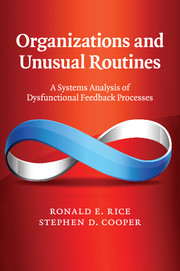Book contents
- Frontmatter
- Contents
- List of figures
- List of tables
- List of boxes
- Preface
- Acknowledgments
- 1 Crazy systems, Kafka circuits, and unusual routines
- 2 Causes, symptoms, and subroutines of unusual routines in six computer information/communication systems
- 3 Getting personal: unusual routines at the customer service interface
- 4 A multi-theoretical foundation for understanding unusual routines
- 5 A detailed case study of unusual routines
- 6 Summary and discussion of the case study results
- 7 Individual and organizational challenges to feedback
- 8 A multi-level and cross-disciplinary summary of concepts related to unusual routines
- 9 Recommendations for resolving and mitigating unusual routines and related phenomena
- 10 Summary and a tentative integrated model of unusual routines
- References
- Index
5 - A detailed case study of unusual routines
Published online by Cambridge University Press: 10 January 2011
- Frontmatter
- Contents
- List of figures
- List of tables
- List of boxes
- Preface
- Acknowledgments
- 1 Crazy systems, Kafka circuits, and unusual routines
- 2 Causes, symptoms, and subroutines of unusual routines in six computer information/communication systems
- 3 Getting personal: unusual routines at the customer service interface
- 4 A multi-theoretical foundation for understanding unusual routines
- 5 A detailed case study of unusual routines
- 6 Summary and discussion of the case study results
- 7 Individual and organizational challenges to feedback
- 8 A multi-level and cross-disciplinary summary of concepts related to unusual routines
- 9 Recommendations for resolving and mitigating unusual routines and related phenomena
- 10 Summary and a tentative integrated model of unusual routines
- References
- Index
Summary
This chapter and Chapter 6 describe how each of the five propositions played out in a lengthy field study at an educational institution (Cooper, 2000), based upon our working model of unusual routines introduced in the preceding chapter. While the initial intent was to focus on the effects the implementation of a computer-mediated communication system (one kind of ICT) might have on URs, the early data collection suggested that the study would provide broader insights into UR dynamics in decision processes and operations. The study utilized depth interviews with a stratified purposive sample of organization members, and such qualitative methodology often does lead to pleasant surprises in the knowledge the study generates. That is to say, the study convinced us that the model had broader application than to ICTs alone, and had particular analytical value in understanding the relationship between problematic routine behaviors and organizational culture. It is important to emphasize that in no way was this intended as an assessment or critique of communication at the site! Indeed, we expect that the URs and interaction scripts surfaced in the study may be all too familiar to our colleagues at other institutions.
Method
The research site
At the time of the study, the organization had just begun a major end user computing initiative to implement a shared database of student records, and to provide email to all faculty and staff. Up to that point, college records had been maintained on a mainframe computer by an information technology (IT) department.
- Type
- Chapter
- Information
- Organizations and Unusual RoutinesA Systems Analysis of Dysfunctional Feedback Processes, pp. 155 - 199Publisher: Cambridge University PressPrint publication year: 2010

